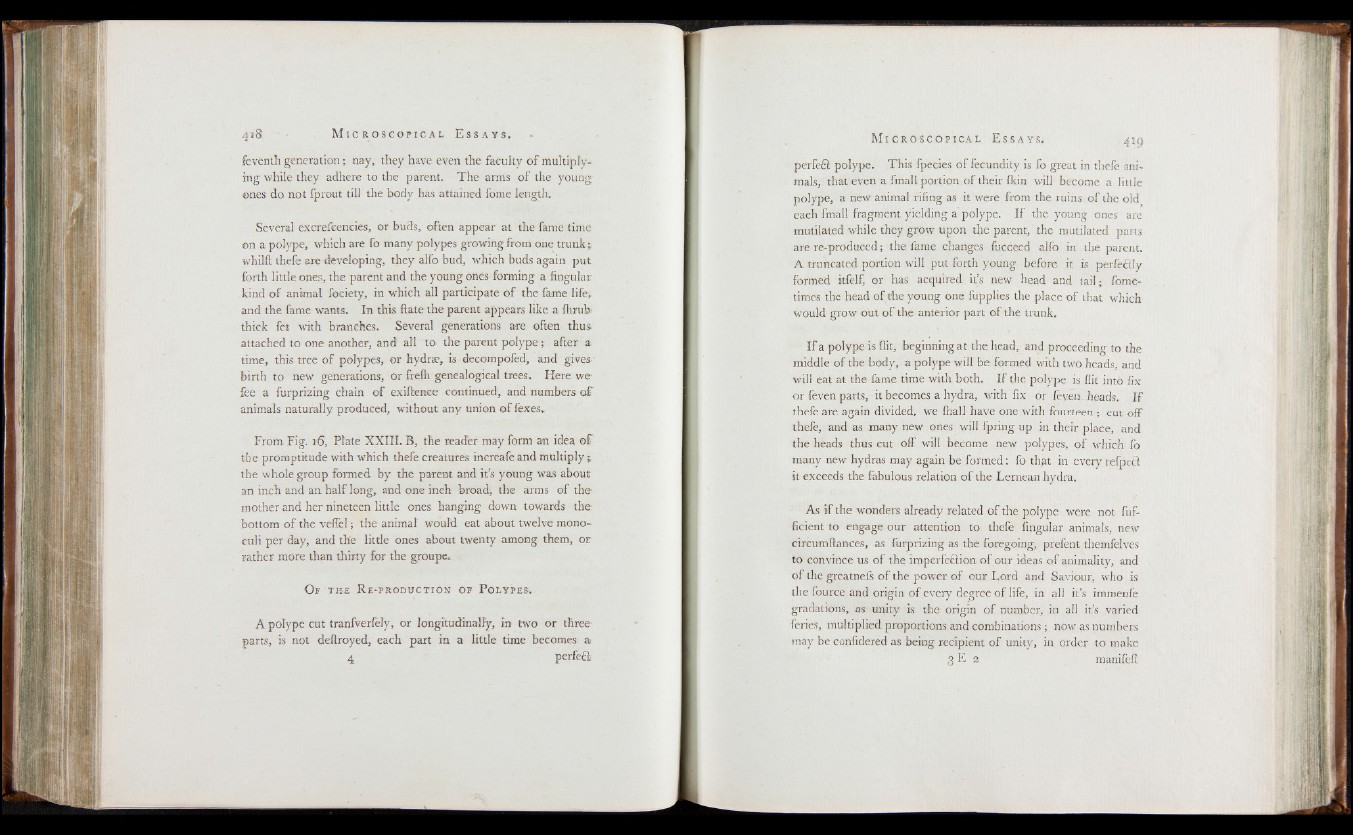
feventh generation; nay, they have even the faculty o f multiplying
while they adhere to the parent. The arms o f the young
ones do not fprout till the body has attained feme length.
Several excrefeeneies, or buds, often appear at the fame time
on a polype, which are fo many polypes growing from one trunk *
whilft thefe are developing, they alfo bud, which buds again put
forth little ones, the parent and the young ones forming a lingular
kind of animal fociety, in which all participate o f the fame life,
and the fame wants. In this ftatethe parent appears like a Ihrub
thick fet with branches. Several generations are often thus,
attached to one another, and all to the parent polype ; after a
time, this tree o f polypes, or hydra?, is decompofed, and gives
birth to new generations, or frelh genealogical trees. Here we-
fee a fu-rprizing chain o f exiftenee continued, and numbers o f
animals naturally produced, without any union of fexes.
From Fig. 16, Plate XXIII. B, the reader may form an idea o f
the promptitude with which thefe creatures increafe and multiply |
the whole group formed by the parent and it’s young was about
an inch and an half long, and one ineh broad, the arms of the-
mother and her nineteen little ones hanging down towards the
bottom o f the veflel; the animal would eat about twelve mono-
euli per day, and the little ones about twenty among them, or
rather more than thirty for the groupe.
O f the R e pr o d u c t io n of Pol ypes .
A polype cut tranfverfely, or longitudinally, in two or three-
parts, is not deftroyed, each part in a little time becomes a
4 ' perfect
perfeft polype. This fpecies of fecundity is fo great in thefe animals,
that even a fmall portion o f their fkin will become a little
polype, a new animal riling as it were from the ruins o f the old
each fmall fragment yielding a polype. I f the young ones' are
mutilated while they grow upon the parent, the mutilated parts
are re-produced; the fame changes fucceed alfo in the parent.
A truncated portion will put forth young before it is perfeflly
formed itfelf, or has acquired it’s new head and tail; fome-
times the head of the young one fupplies the place o f that which
would grow out o f the anterior part of the trunk.
I f a polype is flit, beginning at the head, and proceeding to the
middle of the body, a polype will be formed with two heads, and
will eat at the fame time with both. I f the polype is flit into fix
or feven parts, it becomes a hydra, with fix or fcven- heads. I f
thefe are again divided, we lhall have one with fourteen ; cut off
thefe, and as many new ones will fpring up in their place, and
the heads thus cut off will become new polypes, o f which fo
many new hydras may again be formed: fo that in every refpctf
it exceeds the fabulous relation of the Lernean hydra.
As if the wonders already related o f the polype were not fuf-
ficient to engage our attention to thefe Angular animals, new
circumftances, as furprizing as the foregoing, prefent themfelves
to convince us o f the imperfection of our ideas o f animality, and
o f the greatnefs o f the power of our Lord and Saviour, who is
the fource and origin o f every degree o f life, in all it’s immenfe
gradations^ as unity is the origin o f number, in all it’s varied
feries, multiplied proportions and combinations ; now as numbers
may be confidered as being recipient o f unity, in order to make
3 E 2 manifefl